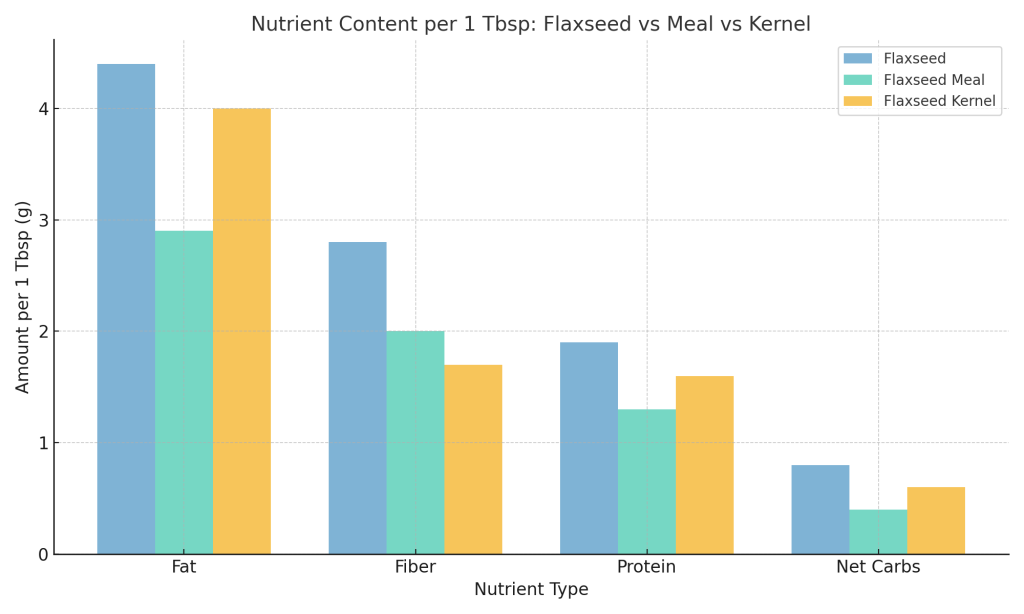Flaxseed has earned a spot as a superfood thanks to its rich nutrient profile. But if you’re watching your calorie intake, you might wonder — how many calories are actually in a tablespoon of flaxseed? And what about flaxseed meal and kernels?
Here is a data-driven comparison of flaxseed forms, including calorie content, nutrient breakdown, and usage recommendations — with insights from scientific sources and food industry applications.
1. General Nutrition Analysis of Flaxseed
Flaxseed (also known as linseed) is packed with alpha-linolenic acid (ALA), fiber, and plant-based protein. It’s also rich in lignans, antioxidants that may offer anti-inflammatory and anti-cancer benefits.
Typical Nutrient Composition per 100g of Whole Flaxseed (USDA, 2024):
| Nutrient | Amount per 100g | % of Calories |
|---|---|---|
| Energy | 534 kcal | 100% |
| Fat | 42.2 g | ~70% |
| Carbohydrates | 28.9 g (fiber ~27g) | ~21% |
| Protein | 18.3 g | ~9% |
| Omega-3 ALA | 22.8 g | — |
🔎 Caloric breakdown:
Fat contributes ~75% of total calories.
Fiber provides bulk without digestible energy (helps with satiety, but has minimal direct caloric value).
Protein and digestible carbohydrates contribute a smaller share.
2. How Many Grams in 1 Tablespoon?
| Product Type | Weight per 1 tbsp (US) | Source |
|---|---|---|
| Whole flaxseed | ~10.3 g | USDA (SR Legacy, 2019) |
| Flaxseed meal | ~7 g | Bob’s Red Mill specs |
| Flaxseed kernels | ~9 g | Manufacturer avg |
Note: 1 tablespoon = 14.8 mL (volume); weights vary due to density and grind.
3. Nutritional Comparison Table: 1 Tbsp Each
| Nutrient (per 1 tbsp) | Flaxseed (10.3g) | Flaxseed Meal (7g) | Flaxseed Kernel (9g) |
|---|---|---|---|
| Calories (kcal) | ~55 | ~37 | ~48 |
| Fat (g) | 4.4 | 2.9 | 4.0 |
| Fiber (g) | 2.8 | 2.0 | 1.7 |
| Protein (g) | 1.9 | 1.3 | 1.6 |
| ALA Omega-3 (g) | 2.4 | 1.7 | 2.1 |
| Carbs (net) | ~0.8 | ~0.4 | ~0.6 |
Key Takeaways:
Flaxseed meal has fewer calories due to being lighter and less oily.
Kernel offers slightly more omega-3 per gram of fat.
Whole flaxseed may not be fully digested unless ground.
Source: USDA (2024); Bob’s Red Mill; Canadian Flax Council.
4. Why Do People Care About Flaxseed Calories?
Here are some user motivations for tracking flaxseed calorie content:
| Concern | Why It Matters | Best Option |
|---|---|---|
| Weight management | High-fat foods are calorie-dense | Flaxseed meal (lower kcal) |
| Keto/low-carb diet | Need low net carbs and healthy fat | Whole/kernels (more fat) |
| Heart health (ALA intake) | More omega-3s with fewer calories | Flaxseed kernel |
| Digestive health | High fiber with lower energy | Flaxseed meal |
| Meal planning & macros | Need precise caloric/macronutrient control | All, depending on the goal |
Recommendation:
Use flaxseed meal for calorie-conscious or high-fiber diets.
Choose kernels or whole seeds for omega-3 and fat-rich nutritional plans.
5. Flaxseed Forms: Industrial Use & Product Development Insights
| Product Type | Food Industry Use | Industrial Advantage | Product Development Ideas |
|---|---|---|---|
| Whole Flaxseed | Bakery toppings, cereals, granola | Stable shelf life, minimal processing | Nutritious crunch in bars/cookies |
| Flaxseed Meal | Baking, smoothies, meat extenders | Easy to blend, cost-effective fiber | High-fiber snacks, plant-based meat |
| Flaxseed Kernel | Oil pressing, premium omega-3 blends | Rich in oil, visually appealing | Omega-3-rich supplements, vegan butter |
🏭 R&D Insight:
Flaxseed meal is ideal for high-fiber functional foods.
Flaxseed kernels are perfect for premium omega-3 positioning.
Whole flaxseed offers sustainability in clean-label foods with minimal processing.
6. Conclusion: Which Flaxseed Form Is Right for You?
Flaxseed is calorically dense — but nutrient-rich. Here’s a quick summary:
1 tbsp of whole flaxseed: ~55 kcal, high in omega-3s and fiber.
1 tbsp of flaxseed meal: ~37 kcal, best for low-calorie, high-fiber diets.
1 tbsp of flaxseed kernels: ~48 kcal, rich in oil and omega-3s.
If you’re aiming to lose weight, flaxseed meal offers the best calorie-to-fiber ratio.
If you’re on a keto or high-fat diet, kernels or whole seeds are more beneficial.
From a product innovation view, each form serves unique roles in food formulation.
References
U.S. Department of Agriculture. (2024). FoodData Central. Retrieved from https://fdc.nal.usda.gov/
Bob’s Red Mill. (n.d.). Flaxseed Meal Product Sheet. Retrieved from https://www.bobsredmill.com/
Flax Council of Canada. (2019). Flaxseed: A Nutritional Powerhouse. Retrieved from https://flaxcouncil.ca/
Institute of Medicine. (2005). Dietary Reference Intakes for Energy, Carbohydrate, Fiber, Fat, Protein, and Amino Acids. National Academies Press. https://doi.org/10.17226/10490







